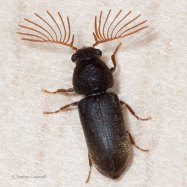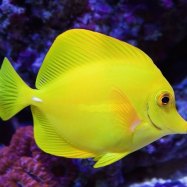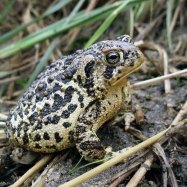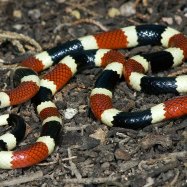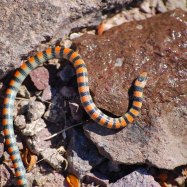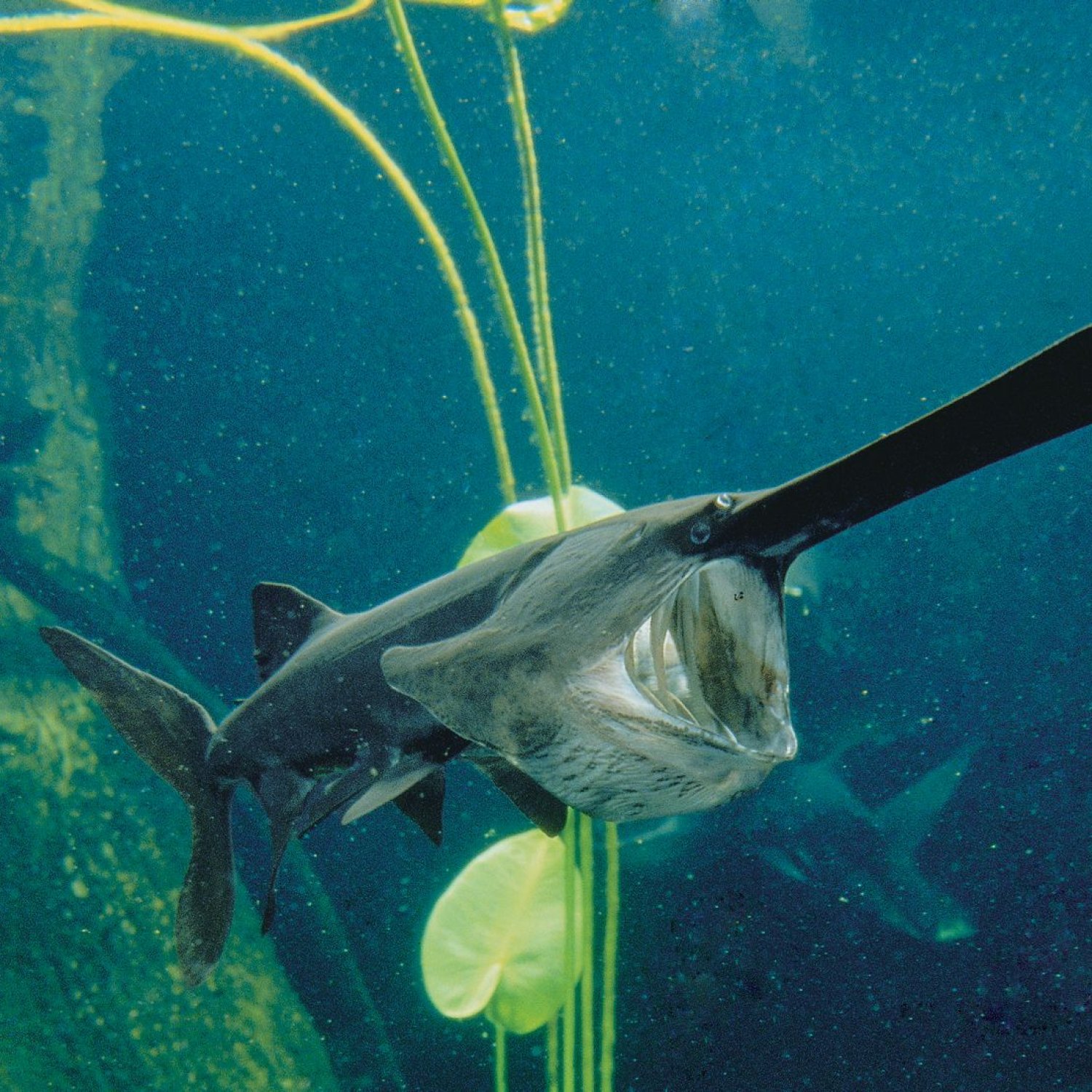
Paddlefish
6-8 feet
The Paddlefish, found in the Mississippi, Missouri, and Ohio rivers, is a unique freshwater fish with a long, slender body that can reach up to 6-8 feet in length. Belonging to the Polyodontidae family, these fish are commonly known for their distinct paddle-like snouts and are considered an important species for maintaining aquatic ecosystems. #Paddlefish #MississippiRiver #MissouriRiver #OhioRiver #freshwaterfish
Animal Details Summary:
Common Name: Paddlefish
Kingdom: Animalia
Habitat: Rivers and freshwater lakes
Discovering the Amazing Paddlefish: North America's Filter Feeder
North America is home to many fascinating and unique animal species, and one of the most intriguing is the paddlefish. With its long and slender body, filter feeding abilities, and impressive size, this freshwater fish has captured the attention of scientists and nature enthusiasts alike. In this article, we will delve into the world of the paddlefish, exploring its taxonomy, habitat, feeding habits, geographical distribution, and other interesting facts.Taxonomy and Classification
The paddlefish, scientifically known as Polyodon spathula, belongs to the Animalia kingdom, the Chordata phylum, and the Actinopterygii class Paddlefish. Its closest relatives are other members of the order Acipenseriformes, such as sturgeons and other paddlefish species. The paddlefish is the only living species in the Polyodontidae family, making it a unique and rare animal.Habitat
Paddlefish are primarily found in rivers and freshwater lakes, with a preference for warm, slow-moving water. They are often found in clear water, where they can detect their surroundings and prey more easily. These fish are native to North America and are commonly found in the Mississippi River, Missouri River, and Ohio River. They have also been introduced to other freshwater bodies, such as reservoirs and impoundments, for commercial and recreational purposes.Feeding Method
One of the most remarkable features of the paddlefish is its filter feeding ability. They have specialized gill rakers that act as a filter, allowing them to feed on plankton, large zooplankton, and small invertebrates. These gill rakers are long and thin, resembling a comb, and are essential in trapping food particles as the fish swims through the water with its mouth open Plesiosaur. Paddlefish can consume several pounds of food per day, making them important contributors to the ecosystem.Geographical Distribution
As previously mentioned, paddlefish are native to North America. They can be found in the United States, with their range extending from the Great Lakes region to the Gulf Coast. The populations are densest in the Mississippi River basin, where an estimated 3.2 million adults exist. They are also found in parts of Canada, specifically in the Red River system.Physical Description
The paddlefish has a distinct appearance, making it easily recognizable. Its body is long and slender, with the average length ranging from 6 to 8 feet. However, some individuals have been known to reach lengths of up to 9 feet. They can weigh anywhere from 60 to 200 pounds, with females being larger than males. The body of the paddlefish is gray or brown on the top, while the belly is white or yellowish in color.Unique Adaptations
Apart from their filter feeding abilities, the paddlefish has other notable adaptations that make them well-suited to their environment. One of these is their cartilaginous skeleton. Unlike most fish, which have bones, the paddlefish's skeleton is composed of cartilage. This gives them a lighter body, allowing them to swim effortlessly through the water.Another unique adaptation is their ability to detect weak electrical fields in the water. Paddlefish have specialized cells called ampullae of Lorenzini that can sense these electrical fields, making them highly sensitive to their surroundings. This adaptation helps them navigate through murky waters and locate potential prey.
Threats and Conservation
The paddlefish population has faced numerous threats, primarily due to overfishing and habitat destruction. In the early 1900s, their numbers declined significantly due to the high demand for their eggs, which were considered a delicacy. Today, their populations continue to be threatened by illegal snagging, where anglers use large hooks to catch and kill paddlefish for their roe. Habitat destruction, such as dam construction and pollution, also poses a threat to their survival.To conserve the paddlefish population, various measures have been put in place. These include regulations on fishing and the installation of fish passages to help them navigate past dams. Furthermore, hatcheries have been set up to reintroduce the species into areas where their population has declined.
Interesting Paddlefish Facts
- While most fish have scales, the paddlefish has smooth skin.- Paddlefish can live for up to 30 years.
- They are currently listed as an endangered species in some states, such as Iowa and Montana.
- Paddlefish are sometimes referred to as "primitive fish" due to their lack of true bones and their cartilaginous skeleton.
- The name "paddlefish" comes from their long, paddle-shaped snout, also called a rostrum.
In Conclusion
The paddlefish is a fascinating and important species in North America. Its unique adaptations, filter feeding abilities, and impressive size make it a noteworthy creature worth studying and protecting. While they may face ongoing threats, efforts are being made to conserve and sustain their populations, ensuring that future generations can also marvel at this incredible freshwater fish. As with all animal species, it is crucial to respect and protect the paddlefish and its habitat, so that it may continue to thrive in its natural environment.

Paddlefish
Animal Details Paddlefish - Scientific Name: Polyodon spathula
- Category: Animals P
- Scientific Name: Polyodon spathula
- Common Name: Paddlefish
- Kingdom: Animalia
- Phylum: Chordata
- Class: Actinopterygii
- Order: Acipenseriformes
- Family: Polyodontidae
- Habitat: Rivers and freshwater lakes
- Feeding Method: Filter feeder
- Geographical Distribution: North America
- Country of Origin: United States
- Location: Mississippi River, Missouri River, Ohio River
- Animal Coloration: Gray or brown on top, white or yellowish on the belly
- Body Shape: Long and slender
- Length: 6-8 feet
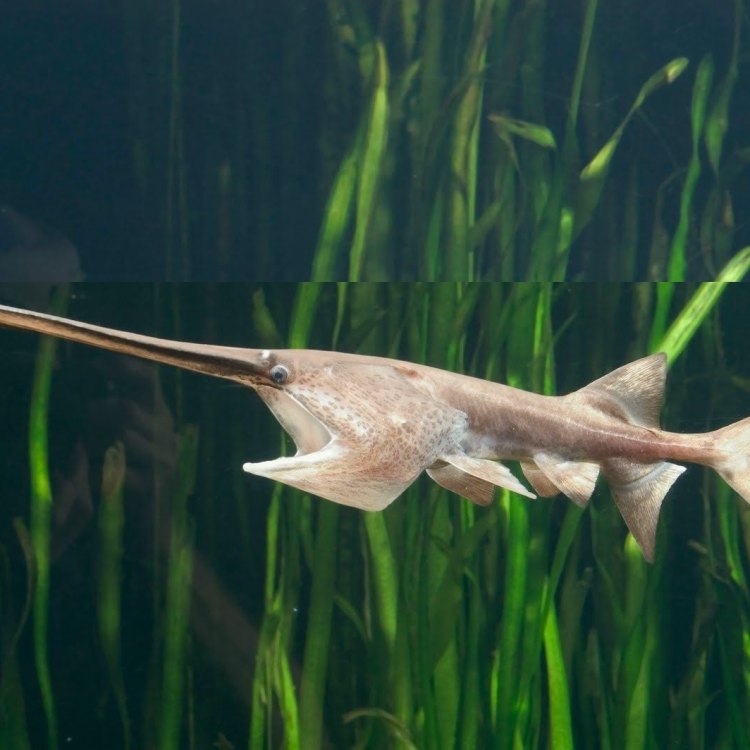
Paddlefish
- Adult Size: Up to 7 feet in length and 200 pounds in weight
- Average Lifespan: up to 50 years
- Reproduction: Sexual
- Reproductive Behavior: Spawning in fast-flowing rivers
- Sound or Call: No sound production
- Migration Pattern: Migratory
- Social Groups: Generally solitary
- Behavior: Bottom-dwelling
- Threats: Overfishing, habitat loss, pollution
- Conservation Status: Vulnerable
- Impact on Ecosystem: Highly important as a filter feeder
- Human Use: Commercial fishing, caviar production
- Distinctive Features: Long, paddle-like rostrum
- Interesting Facts: Paddlefish are ancient species that have been around for over 300 million years. They are considered living fossils.
- Predator: Larger fish
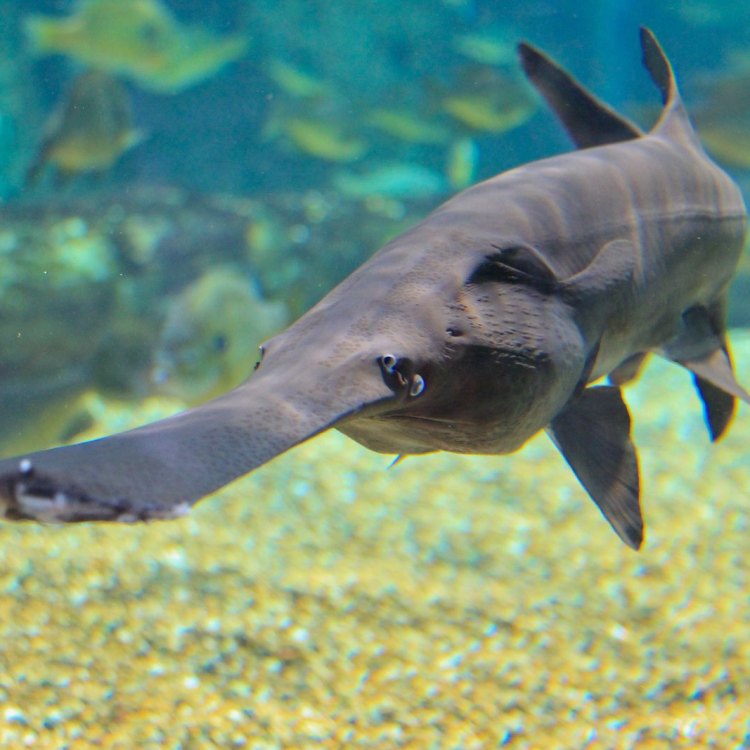
Polyodon spathula
The Ancient and Unique Paddlefish: A Living Fossil in Today's World
When you think of a fish, what image comes to mind? A sleek and agile creature, gliding through the water with ease. But have you ever heard of a fish with a paddle-like snout, capable of growing up to 7 feet in length and weighing as much as 200 pounds? Meet the paddlefish, a unique species that has been around for over 300 million years and is considered a living fossil.The paddlefish, also known as the spoonbill, is a fascinating creature that inhabits the rivers and lakes of North America. Found in the Mississippi River system, as well as other major rivers and lakes across the central and eastern United States, the paddlefish has captured the attention of scientists and fishermen alike PeaceOfAnimals.Com.
Let's dive into the world of the paddlefish and discover the incredible features and behaviors that make this ancient species so unique.
The Paddlefish: An Enormous and Intriguing Fish
The first thing that stands out about the paddlefish is its size. This fish can grow up to 7 feet in length and reach weights of over 200 pounds, making it one of the largest freshwater fish in North America. It is also one of the longest-lived freshwater fish, with an average lifespan of up to 50 years. With its impressive size and lifespan, the paddlefish is truly a remarkable species.Reproduction and Behavior: The Unique Mating Habits of the Paddlefish
The paddlefish is a sexually reproductive species, with males and females coming together to spawn during the spring season. What makes their reproductive behavior truly fascinating is their choice of location for spawning. Paddlefish prefer to lay their eggs in fast-flowing rivers, where the current can help disperse their eggs to ensure better survival rates for their offspring.Once the eggs are fertilized, the female paddlefish can produce up to 2 Puff Adder.5 million eggs, making it a significant contributor to the overall species' population. After the eggs are laid, they will hatch in about a week, and the young paddlefish will start their journey in the river, facing many challenges and predators along the way.
When it comes to behavior, the paddlefish is a bottom-dwelling fish, spending most of its time in deeper waters. They are generally solitary creatures, only coming together during the spawning season, where they form small groups in fast-flowing rivers.
The Unique Features of the Paddlefish: The Rostrum
The most distinctive feature of the paddlefish is, without a doubt, its long and paddle-like rostrum or snout. The fish's snout can reach up to one-third of its body length, making it an essential tool for navigating and finding food in the murky waters. Contrary to popular belief, the rostrum is not used for digging or burrowing in the riverbed, as seen in other fish species.The rostrum of the paddlefish is covered in sensory receptors called electroreceptors, which allow the fish to detect changes in electric fields in the water. This helps the fish locate their prey, mainly small fish and crustaceans, which they then capture by using their gill rakers.
Threats to the Paddlefish: A Vulnerable Species
Despite their incredible attributes, the paddlefish population is facing numerous threats. The most significant threat is overfishing, as they are a highly desired species for commercial fishing and caviar production. The caviar industry is a multi-million dollar business, and paddlefish roe is considered some of the best in the world.Additionally, habitat loss and pollution have also contributed to the decline of the paddlefish population. Dams and other human-made structures have disrupted their natural migration pathways, and the decline in water quality due to pollution has affected their ability to thrive. These factors, combined with their slow reproductive rate, have resulted in the paddlefish's vulnerable conservation status.
The Importance of Paddlefish in the Ecosystem
Aside from being a highly sought-after species for human consumption, paddlefish also play a crucial role in their ecosystem. As bottom-dwelling filter feeders, they help maintain the balance of nutrients in the water by removing harmful bacteria and algae. They also serve as an essential food source for larger fish and other aquatic species, making them a vital link in the food chain.Furthermore, the decline of the paddlefish population can have severe consequences for the entire ecosystem. Without their filtration and grazing abilities, the water quality can deteriorate, leading to the decline of other species that rely on it.
The Future of the Paddlefish: A Cautionary Tale
The paddlefish's unique features and behaviors make it a truly one-of-a-kind species, and its population decline is a cause for concern. However, efforts are being made to conserve and preserve this incredible species. Several organizations and government agencies have implemented regulations and conservation measures to protect the paddlefish from overfishing and other threats.Furthermore, scientific research is being conducted to better understand the paddlefish and its behaviors, especially regarding its spawning behavior. With this knowledge, scientists can develop better strategies for the conservation and management of the paddlefish population.
Conclusion
The paddlefish is a living fossil, a unique and ancient species that has adapted and thrived in North America's rivers and lakes for millions of years. Its impressive size, long lifespan, and distinctive features make it a truly fascinating fish. Sadly, the paddlefish is facing numerous threats, and its survival is at stake.It is our responsibility to conserve and protect this incredible species for future generations to come. By raising awareness about the paddlefish's importance and the need for conservation efforts, we can ensure that this living fossil continues to grace the waters of North America for many years to come.
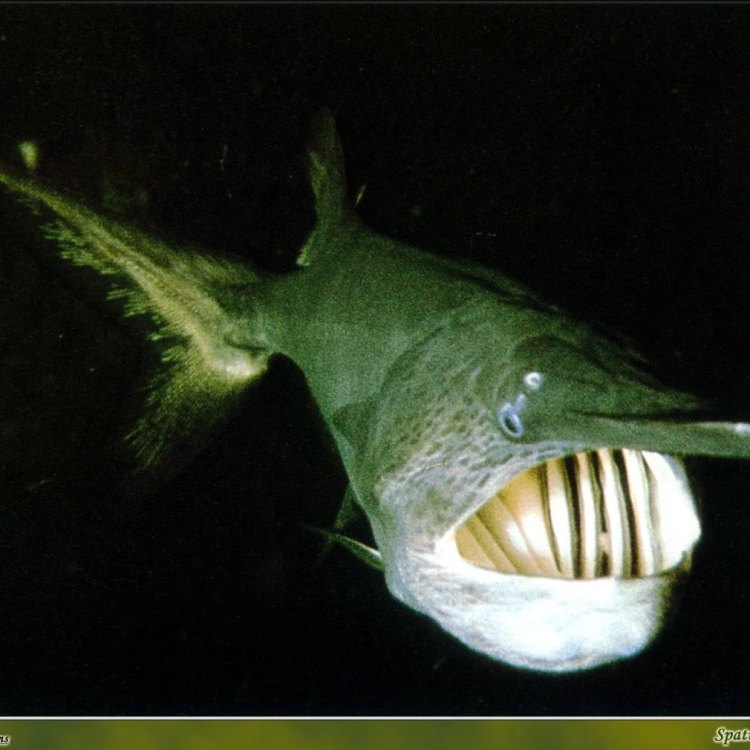
Discovering the Amazing Paddlefish: North America's Filter Feeder
Disclaimer: The content provided is for informational purposes only. We cannot guarantee the accuracy of the information on this page 100%. All information provided here may change without prior notice.






